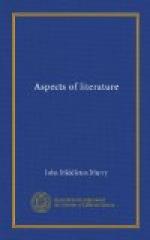Only those who do not read Mr Hardy could make the mistake of supposing that on his lips such a phrase had a mystical implication. Between belief and logic lies a third kingdom, which the mystics and the philosophers alike are too eager to forget—the kingdom of art, no less the residence of truth than the two other realms, and to some, perhaps, more authentic even than they. Therefore when we expand the word ‘vision’ in the phrase to ‘aesthetic vision’ we mean, not the perception of beauty, at least in the ordinary sense of that ill-used word, but the apprehension of truth, the recognition of a complete system of valid relations incapable of logical statement. Such are the acts of unique apprehension which Mr Hardy, we believe, implied by his title. In a ‘moment of vision’ the poet recognises in a single separate incident of life, life’s essential quality. The uniqueness of the whole, the infinite multiplicity and variety of its elements, are manifested and apprehended in a part. Since we are here at work on the confines of intelligible statement, it is better, even at the cost of brutalising a poem, to choose an example from the book that bears the mysterious name. The verses that follow come from ‘Near Lanivet, 1872.’ We choose them as an example of Mr Hardy’s method at less than its best, at a point at which the scaffolding of his process is just visible.
’There was a stunted hand-post just
on the crest.
Only a few feet high:
She was tired, and we stopped in the twilight-time
for her rest,
At the crossways close thereby.
’She leant back, being so weary,
against its stem,
And laid her arms on its own,
Each open palm stretched out to each end
of them,
Her sad face sideways thrown.
’Her white-clothed form at this
dim-lit cease of day
Made her look as one crucified
In my gaze at her from the midst of the
dusty way,
And hurriedly “Don’t,”
I cried.
’I do not think she heard.
Loosing thence she said,
As she stepped forth ready
to go,
“I am rested now.—Something
strange came into my head;
I wish I had not leant so!’...
’And we dragged on and on, while
we seemed to see
In the running of Time’s
far glass
Her crucified, as she had wondered if
she might be
Some day.—Alas,
alas!’
Superstition and symbolism, some may say; but they mistakenly invert the order of the creative process. The poet’s act of apprehension is wholly different from the lover’s fear; and of this apprehension the chance-shaped crucifix is the symbol and not the cause. The concentration of life’s vicissitude upon that white-clothed form was first recognised by a sovereign act of aesthetic understanding or intuition; the seeming crucifix supplied a scaffolding for its expression; it afforded a clue to the method of transposition into words which might convey the truth thus apprehended;




